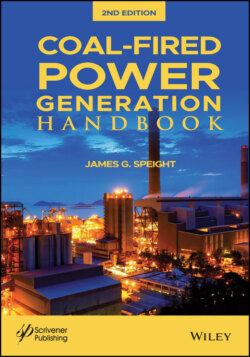Читать книгу Coal-Fired Power Generation Handbook - James Speight G., James G. Speight - Страница 66
3.5.1 Effect of Composition and Rank
ОглавлениеWhen coals are combusted or pyrolyzed, there is the near complete elimination of hydrogen and oxygen – the carbon residue that remains, however, still contains small quantities of nitrogen and sulfur. Typical values for carbon, hydrogen, volatile matter (i.e., low molecular weight products of the pyrolysis), and residual (fixed, non-volatile) carbon of the various classes of coal (Table 3.2) provide the basis of a system for describing coal rank (Speight, 2013).
In the context of coal cleaning, oxygen is often considered unimportant because it is nonpolluting! But some consideration should be given to the effect of oxygen on the fate of its nitrogen and sulfur compatriots as well as its effect when water (a product of the combustion of hydrocarbons which also contain oxygen) condenses with other by-products on the cooler parts of combustion systems; corrosive, aqueous acids can be the result.
Sulfur is a special case because it is considered to be, and actually is, a more a serious pollutant than oxygen. Sulfur occurs in various forms and is distributed throughout the organic matrix and in the minerals. As organic sulfur, it occurs in the organic structure of the coal and as pyritic sulfur, it occurs as discrete particles of pyrite (Fe). In addition, sulfates are occasionally found in the minerals. In summary, the bulk of the sulfur (organic and/or inorganic) present in coal has the potential to occur as gaseous combustion products.
Rank has been assumed to have an effect on the extent of hydrophobic character of coal (Speight, 2013). However, recent work on the prediction of coal hydrophobicity indicates that this property correlates better with the moisture content than with the carbon content and better with the moisture/carbon molar ratio than with the hydrogen/ carbon or oxygen/carbon atomic ratios (Labuschagne et al., 1988). Thus, it appears that there is a relationship between the hydrophobicity of coal and the moisture content. But there are differences in the behavior of coals and the differences are usually referred to as wettability, which can be quantified by measurement of the contact angle of the solid with water.
